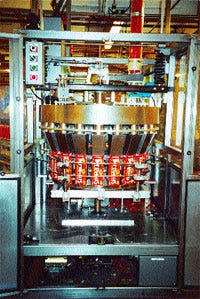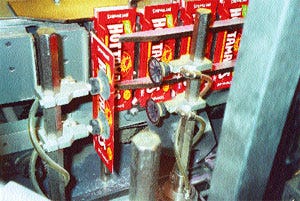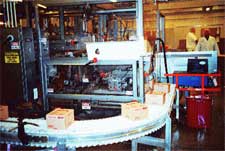January 29, 2014
|
Product feeds down an in-house-built tube into the 24-station rotary weigh/fill cups of the new cartoner. |
Quality consists of "small, value-added touches" that come only from exercising total control over a package and the equipment with which it is handled. "This equipment must give us up to ninety-nine percent uptime, so we selected it based on architecture and performance, rather than on cost," says Al Tullock, manager of packaging at Just Born, a confections marketer based in Bethlehem, PA, during a PD visit last month.
The architecture he cites is Line #7, which is packaging the capsule-shaped, soft, chewy, non-gritty, flavor-focused candies for which the company is known internationally. During the visit, the brand being cartoned is the company's best-selling cinnamon-flavored Hot Tamales® candy packaged in 8-oz quantities.
The visit's rationale is the new vertical cartoner that considerably boosts line output. Its true motive is to show how Just Born, in its third generation of the Born family's guidance, is serving a "much more competitive marketplace, where buyers are looking at profit per square foot, and where there's a critical need to maintain quality while producing better, faster," Tullock explains.
"To get to this point," he says, "we launched a program not only to replace an older cartoner, but also to bring in a machine that would satisfy the requirements of our plant staff, whose enlightened perspectives we value highly. So, together with senior packaging technologist Frank J. Olszewski, we chose five manufacturers and invited them to tell us about their machines. We visited several of them, then brought them into our plant and had them make presentations to our people, who rated them first, second and third."
Taking product and carton blanks to the manufacturers' plants for packaging on the candidate machines further helped shorten the list. Selecting the supplier, Tullock recalls, was simple. "Their people listened to us and met our needs," he says.
The company chosen, Z Automation Co., builds a cartoner based on a standard platform but with unique features modeled according to Just Born's specific requirements. To handle its higher potential output than the 102 carton-per-minute speed of the previous cartoner, the marketer built a vertical, clear, tubular gravity feed for the capsule-shaped candy.
|
Positive opening of the carton blanks is done by two pairs of suction cups. Hot-melt adhesive is applied to the bottom dust flap. |
"Positioned at the top of the packaging line, the cartoner is living up to all our expectations," Tullock says. "Back in November, it was installed on a Tuesday. By the morning of the next day, it was operating at 100 per minute. By that afternoon, it was running at 142 to 144 cartons per minute, which is about where we keep it because of downstream constraints, which we are planning to remove in the next six to nine months." It's also the final step in a packaging line that once needed five people to run it, but that now is handled by a single operator.
Starts at the top
Customization of the basic cartoner, the Model ZCV200VF six-head rotary blank feeder developed specifically for food industry applications, starts at the top with a rotary 24-station weigher/filler cup assembly. First are the vibratory funnel and base that hasten fill and product settling in the cartons, opened by opposing pairs of suction cups, and bottom-tucked and glued by a dot of Henkel hot-melt adhesive deposited by a Slautterback/Nordson applicator.
Along with these features, the oval-shaped-track cartoner has an orienting overhead belt just before discharge, permitting gentle movement to a horizontal position that also spaces the cartons just after they receive another hot-melt adhesive application under the upper dust flap. Says Z Automation president Zoran Momich, "With its quiet, efficient operation, our vertical cartoner is the only machine made that requires no tools to change the funnel or other parts. All components snap in and out."
This is especially significant to Al Tullock, because along with the 1/2-lb carton is an 8.8-oz box used in certain kinds of distribution. "This is an example of the kind of equipment architecture that we study closely," he notes, "since it so vitally affects the uptime equation."
Integrating the cartoner into the system also has an impact on the carton. Older machines tend to be forgiving where package specifications are concerned. But Tullock's standards aren't.
|
Overhead belt guides assert control over the cartons as they exit the cartoner. |
"Here," he states, "we demand a full package that looks as good as it possibly can." So, as the cartoner was being started up, he acquired the latest version of a force/bending tester from Thwing-Albert Instrument, a Meisner tester from Testing Machines, Inc. (TMI), and other analytical equipment.
A search gets underway
Together with the carton manufacturer, Eureka Paper Box, Just Born not only re-examined the carton specifications but also searched for an optimal structure. Eureka also bought a PCA tester, and a spokesperson tells PD that Eureka's people went from "finger feel" to a much more scientific approach. "We started paying very close attention to factors like opening coefficient, score bends and coefficient of friction," he says, which affected not only the basic stock quality but also inks and coatings.
The result is a totally new specification based on performance with the cartoner. It is made within a 950- to 1,350-g opening force range; the score bend window is 20 to 40 g. The carton board is a .016 SBS from Westvaco. Eureka prints the Hot Tamales carton in five colors plus an in-line aqueous coating on a Planeta 7-color offset press.
So the cartons, with a reject rate that reportedly wasn't much of a factor before and is even less now, behave beautifully as they fill, close and space out of the cartoner and pass through a Goring Kerr metal detector, says Just Born. The cartons convey to a wraparound case packer, Smurfit Stone's Model 350, now about four years old. Here, 12 grouped cartons form the mandrel for a case blank, fabricated by Impress Industries of 150# test, B-flute corrugated, that is wrapped and hot-melt-sealed by a Nordson unit with Henkel adhesive.
|
A timing device spaces the cartons as they pass through a metal detector and feed downstream to the casing machine. |
|
Purchased four years ago, the wraparound case packer easily keeps pace with the cartoner. |
Moving through two banks of three Marsh ink-jet coders from Videojet Technologies that give Just Born two end codes, rather than the required one, Tullock comments, the cases are lifted into a Just Born-built elevator. This sends them downstream to a Fanuc Model M410I multifunction robot, installed at the same time as the case wrapper, that handles the output of four packaging lines. There are 12 additional packaging lines in toto; most of them run off Allen-Bradley's 5/04 programmable logic controller using Data Highway+® software.
Multisourced wooden pallets, fully loaded, are transferred by truck to a bank of ITW Mima's Cobra III stretch wrappers for overwrapping with a high-performance stretch film that improves the pallets' appearance and performance. It's a 70-ga metallocene- and althacene-based, five-layer polyethylene copolymer, AEP's AA 11/70, acquired through Industrial Packaging Supply. The film offers remarkable clarity that permits scanning of the case bar codes.
With the new cartoner's integration already a fait accompli, Al Tullock is now directing his attention to the downstream equipment. Already in touch with Videojet Technologies for newer Marsh coders, he says he's also looking at expanding other capabilities to let the cartoner open up. "We have a thoroughbred here," he says, "and we're racing it toward the 220-a-minute level with the expectation of reaching 280-a-minute with absolutely no loss to the quality of the final package. And we're keeping it operating at ninety-nine-percent efficiency in a three-shift, five-day schedule."
Now that's sweetening the pot.
More information is available:
Cartoner: Z Automation Co., 847/483-0120. Circle No. 201.
Hot-melt applicator: Slautterback/Nordson, 800/800/827-3308. Circle No. 202.
Adhesive: Henkel Adhesives, 847/468-9200. Circle No. 203.
Tester: Thwing-Albert Instrument Co., 215/637-0100. Circle No. 204.
Tester: Testing Machines. Inc. (TMI), 800/678-3221. Circle No. 205.
Carton: Eureka Paper Box, 570/326-9147. Circle No. 206.
Paperboard: Westvaco Corp., 800/551-6466. Circle No. 207.
Press: Planeta North America, 516/466-3900. Circle No. 208.
Metal detector: Goring Kerr, 630/734-3334. Circle No. 209.
Case packer: Smurfit-Stone Container Corp., 407/843-1300. Circle No. 210.
Case blank: Impress Industries, 610/966-8500. Circle No. 211.
Coders: Videojet Technologies, Inc., 800/654-4663 Circle No. 212.
Robot: Fanuc Robotics North America, 800/477-6268. Circle No. 213.
PLC: Allen-Bradley, 414/382-2000. Circle No. 214.
Stretch wrapper: ITW Mima, 800/662-6462. Circle No. 215.
Film: AEP Industries, 201/641-6600. Circle No. 216.
Film representative: Industrial Packaging Supply, 800/233-5288. Circle No. 217.
About the Author(s)
You May Also Like







